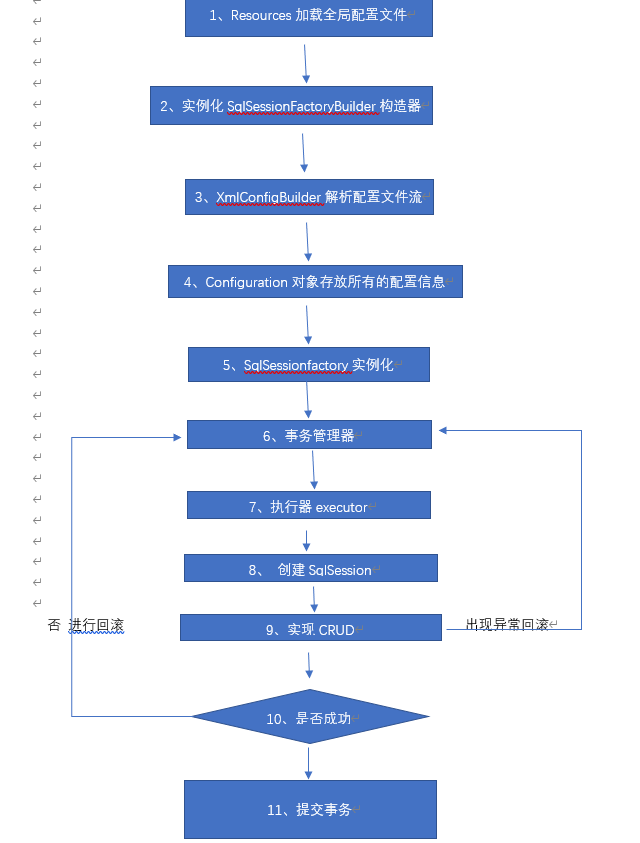Maven资源导出的配置
!-- build中配置resources,防止资源导出失败-->
<build>
<resources>
<resource>
<directory>src/main/resources</directory>
<includes>
<include>**/*.properties</include>
<include>**/*.xml</include>
</includes>
<filtering>true</filtering>
</resource>
<resource>
<directory>src/main/java</directory>
<includes>
<include>**/*.properties</include>
<include>**/*.xml</include>
</includes>
<filtering>true</filtering>
</resource>
</resources>
</build>
<!-- 设置 property 变量 的编码为UTF-8 -->
<properties>
<project.build.sourceEncoding>UTF-8</project.build.sourceEncoding>
</properties>
Mybatis-config.xml的配置
<?xml version="1.0" encoding="UTF-8" ?>
<!DOCTYPE configuration
PUBLIC "-//mybatis.org//DTD Config 3.0//EN"
"http://mybatis.org/dtd/mybatis-3-config.dtd">
<configuration>
<!--引入配置文件 可以在其中添加一些配置 如果添加的属性配置与配置文件中属性配置同名 优先使用配置文件中的配置-->
<properties resource="db.properties"></properties>
<!-- 类型别名的配置-->
<typeAliases>
<!-- 给具体的类起一个别名-->
<!-- <typeAlias type="com.demo4.pojo.User" alias="User"></typeAlias>-->
<!-- 也可以指定一个包名 MyBatis会在包中搜索需要的javaBan 包中所有的类的别名为类的首字母小写
若有注解 则别名为其注解的值
@Alias("Hello")
public class User {
} -->
<package name="com.demo4.pojo"></package>
</typeAliases>
<!--环境的配置-->
<environments default="test">
<environment id="development">
<transactionManager type="JDBC"/>
<dataSource type="POOLED">
<property name="driver" value="${driver}"/>
<property name="url" value="${url}"/>
<property name="username" value="${username}"/>
<property name="password" value="${password}"/>
</dataSource>
</environment>
<environment id="test">
<transactionManager type="JDBC"/>
<dataSource type="POOLED">
<property name="driver" value="${driver}"/>
<property name="url" value="${url}"/>
<property name="username" value="${username}"/>
<property name="password" value="${password}"/>
</dataSource>
</environment>
</environments>
<!-- 映射器的配置-->
<mappers>
<!-- 资源绑定 (推荐使用)-->
<mapper resource="com/demo4/dao/UserMapper.xml"></mapper>
<!-- 类绑定 接口和她的mapper配置文件必须同名 接口和她的mapper配置文件必须在同一个包下-->
<!-- <mapper class="com.demo4.dao.UserMapper"></mapper>-->
<!-- 扫描包绑定 接口和她的mapper配置文件必须同名 接口和她的mapper配置文件必须在同一个包下 -->
<!-- <package name="com.demo4.dao"></package>-->
</mappers>
</configuration>
MybatisUtils工具类
public class MybatisUtils {
private static SqlSessionFactory sqlSessionFactory;
static {
try {
String resource = "mybatis-config.xml";
InputStream inputStream = Resources.getResourceAsStream(resource);
sqlSessionFactory = new SqlSessionFactoryBuilder().build(inputStream);
} catch (IOException e) {
e.printStackTrace();
}
}
public static SqlSession getSqlSession() {
return sqlSessionFactory.openSession();
}
}
映射的配置
<?xml version="1.0" encoding="UTF-8" ?>
<!DOCTYPE mapper
PUBLIC "-//mybatis.org//DTD Mapper 3.0//EN"
"http://mybatis.org/dtd/mybatis-3-mapper.dtd">
<mapper namespace="com.mybatis.dao.UserMapper">
<select id="getUserList" resultType="com.mybatis.pojo.User">
select * from user
</select>
<select id="getUser" parameterType="int" resultType="com.mybatis.pojo.User">
select * from user where id = #{id}
</select>
<!-- 添加-->
<insert id="insertUser" parameterType="com.mybatis.pojo.User">
insert into user(id,name,pwd) values(#{id},#{name},#{pwd})
</insert>
<!--修改-->
<update id="updateUser" parameterType="com.mybatis.pojo.User">
update user set name=#{name},pwd=#{pwd} where id = #{id}
</update>
<!-- 删除-->
<delete id="deleteUserById" parameterType="int">
delete from user where id = #{id}
</delete>
</mapper>
//注意点 增删改需要提交事务
数据库中的字段与实体类属性不一致的解决办法
1、在sql语句中对字段与属性不一样的字段起别名
//实体类
public class User {
private int id;
private String name;
private String password;
}
//数据库中的字段 id name pwd
//配置的sql语句
<select id="getUser" resultType="user" parameterType="_int">
select id,name,pwd as password from user where id = #{id}
</select>
2、resultMap
<resultMap id="userMap" type="user">
<!-- column代表数据库中的字段 property代表实体类中的属性-->
<result column="id" property="id"></result>
<result column="name" property="name"></result>
<result column="pwd" property="password"></result>
</resultMap>
<select id="getUser" parameterType="_int" resultMap="userMap">
select * from user where id = #{id}
</select>
Log4j的使用
1、引入依赖
<dependency>
<groupId>log4j</groupId>
<artifactId>log4j</artifactId>
<version>1.2.17</version>
</dependency>
2、创建配置文件log4j.properties 进行配置
log4j.rootLogger=DEBUG,console,file
#控制台输出的配置
log4j.appender.console = org.apache.log4j.ConsoleAppender
log4j.appender.console.Target = System.out
log4j.appender.console.Threshold = DEBUG
log4j.appender.console.layout = org.apache.log4j.PatternLayout
log4j.appender.console.layout.ConversionPattern = [%c]-%m%n
#文件输出的相关设置
log4j.appender.file = org.apache.log4j.RollingFileAppender
log4j.appender.file.File = ./log/zhang.log
log4j.appender.file.MaxFileSize = 10mb
log4j.appender.file.Threshold = DEBUG
log4j.appender.file.layout = org.apache.log4j.PatternLayout
log4j.appender.file.layout.ConversionPattern = [%p][%d{yy-MM-dd}]{%c}%m%n
#日志输出级别
log4j.logger.org.mybatis = DEBUG
log4j.logger.java.sql = DEBUG
log4j.logger.java.sql.Statement = DEBUG
log4j.logger.java.sql.ResultSet = DEBUG
log4j.logger.java.sql.PreparedStatement = DEBUG
3、在mybatis-config.xml文件中进行设置
<!-- 设置-->
<settings>
<!-- 配置标准的日志工厂-->
<!-- <setting name="logImpl" value="STDOUT_LOGGING"></setting>-->
<!-- 配置log4j日志工厂-->
<setting name="logImpl" value="LOG4J"></setting>
</settings>
4、在需要使用log4j的类中到包 import org.apache.log4j.Logger;
参数为 当前类.class
private static Logger logger = Logger.getLogger(参数);
5、日志级别
logger.info("info: Log4jTest");
logger.debug("info: Log4jTest");
logger.error("info: Log4jTest");
使用注解(适合简单的sql语句)
1、
public interface UserMapper {
@Select("select * from user")
List<User> getUserList();
//方法存在多个参数时 要加@Param("id")的注解
//关于@Param()注解
//基本类型和String类型的参数要加
//引用类型不需添加
//如果只有一个基本类型的可以忽略 但建议加上
@Select("select * from user where id = #{id}")
User getUser(@Param("id") int id);
@Insert("insert into user(id,name,pwd) values(#{id},#{name},#{password})")
int insertUser(User user);
@Update("update user set name=#{name},pwd=#{password} where id = #{id}")
int updateUser(User user);
@Delete("delete from user where id = #{id}")
int deleteUser(int id);
}
2、在mybatis-config.xml中绑定接口
<mappers>
<mapper class="com.demo5.dao.UserMapper"></mapper>
</mappers>
mybatis的执行流程

设置自动提交事务
// sqlSessionFactory.openSession(true); 参数设置为true会自动提交事务
public static SqlSession getSqlSession() {
return sqlSessionFactory.openSession(true);
}
多表查询(多对一)
例如
多个学生对应一个老师
public class Student {
private int id;
private String name;
private int tid;
private Teacher teacher;
}
public class Teacher {
private int id;
private Striing name
}
sql语句
<select id="getStudentList2" resultMap="StudentTeacher2">
select s.id sid,s.name sname,t.name tname
from Student s,teacher t
where s.tid = t.id
</select>
<resultMap id="StudentTeacher2" type="Student">
<result property="id" column="sid"></result>
<result property="name" column="sname"></result>
//javaType 是属性的类型 oftype为属性的泛型的类型
<association property="teacher" javaType="Teacher">
<result property="name" column="tname"></result>
</association>
</resultMap>
或
<select id="getStudentList" resultMap="StudentTeacher">
select * from student
</select>
<resultMap id="StudentTeacher" type="Student">
<result property="id" column="id"></result>
<result property="name" column="name"></result>
<association property="teacher" column="tid" javaType="Teacher" select="getTeacher"></association>
</resultMap>
<select id="getTeacher" resultType="Teacher">
select * from teacher where id = #{id}
</select>
多表查询(一对多)
public class Student {
private int id;
private String name;
private int tid;
}
public class Teacher {
private int id;
private String name;
private List<Student> students;
}
sql查询
<select id="getTeacher" resultMap="TeacherStudent">
select s.id sid,s.name sname,t.id tid,t.name tname
from student s,teacher t
where s.tid = t.id and t.id = #{id}
</select>
<resultMap id="TeacherStudent" type="Teacher">
<result property="id" column="tid"></result>
<result property="name" column="tname"></result>
<collection property="list" ofType="Student">
<result property="id" column="sid"></result>
<result property="name" column="sname"></result>
<result property="tid" column="tid"></result>
</collection>
</resultMap>
或
<select id="getTeacher" resultMap="TeacherStudent2">
select * from teacher where id = #{id}
</select>
<resultMap id="TeacherStudent2" type="Teacher">
<collection property="list" javaType="ArrayList" ofType="Student" select="getStudent" column="id"></collection>
</resultMap>
<select id="getStudent" resultType="Student">
select * from student where tid = #{tid}
</select>
动态Sql(利用相应的标签来拼接不同条件下的sql语句)
public interface BlogMapper {
int insertBlog(Blog blog);
List<Blog> getBlogList(Map<String,Object> map);
int updateBlog(Map<String,Object> map);
List<Blog> getBlogForEach(Map<String,Object> map);
}
<!DOCTYPE mapper
PUBLIC "-//mybatis.org//DTD Mapper 3.0//EN"
"http://mybatis.org/dtd/mybatis-3-mapper.dtd">
<mapper namespace="com.demo8.dao.BlogMapper">
<insert id="insertBlog" parameterType="Blog">
insert into blog(id,title,author,create_time,views) values(#{id},#{title},#{author},#{createTime},#{views})
</insert>
<select id="getBlogList" parameterType="map" resultType="Blog">
select * from blog
<where>
<!-- <if test="title != null" >-->
<!-- title = #{title}-->
<!-- </if>-->
<!-- <if test="author != null">-->
<!-- and author = #{author}-->
<!-- </if>-->
<choose>
<when test="title != null">
title = #{title}
</when>
<when test="author != null">
and author = #{author}
</when>
<otherwise>
and views = #{views}
</otherwise>
</choose>
</where>
</select>
<!-- sql标签抽取公共的sql语句 提高复用性-->
<sql id="if-title-author">
<if test="title != null">
title = #{title},
</if>
<if test="author != null">
author = #{author}
</if>
</sql>
<update id="updateBlog" parameterType="map">
update blog
<set>
<!-- 引用抽取的公共sql语句-->
<include refid="if-title-author"></include>
</set>
where id = #{id}
</update>
<select id="getBlogForEach" parameterType="map" resultType="Blog">
select * from blog
where id in
<foreach collection="ids" item="id" open=" (" close=")" separator=",">
#{id}
</foreach>
</select>
</mapper>
测试foreach的的代码
@Test
public void test3() {
SqlSession sqlSession = MybatisUtils.getSqlSession();
BlogMapper mapper = sqlSession.getMapper(BlogMapper.class);
Map<String,Object> map = new HashMap<String, Object>();
List<Integer> ids = new ArrayList<Integer>();
ids.add(1);
ids.add(2);
ids.add(3);
ids.add(4);
map.put("ids",ids);
List<Blog> blogForEach = mapper.getBlogForEach(map);
for (Blog blog : blogForEach) {
System.out.println(blog);
}
sqlSession.close();
}
开启全局缓存
1、在mybatis-config.xml配置文件中设置开启全局缓存
<settings>
<setting name="logImpl" value="LOG4j"></setting>
<!--开启驼峰命名自动转换-->
<setting name="mapUnderscoreToCamelCase" value="true"></setting>
<!-- 开启全局缓存-->
<setting name="cacheEnabled" value="true"></setting>
</settings>
2、//默认情况下,只启用了本地的会话缓存(一级),它仅仅对一个会话中的数据进行缓存。 要启用全局的二级缓存,只需要在你的 SQL 映射文件中添加一行
<cache eviction="FIFO"
flushInterval="60000"
size="512"
readOnly="true"/>
3、<select useCache="true"></seclect>
注意:
>只要开启二级缓存,在用一个映射文件下有效
>所有的数据会先放在一级缓存中
>只有当会话提交,或关闭时才会提交到耳机缓存中
版权声明:本文内容由互联网用户自发贡献,该文观点与技术仅代表作者本人。本站仅提供信息存储空间服务,不拥有所有权,不承担相关法律责任。如发现本站有涉嫌侵权/违法违规的内容, 请发送邮件至 [email protected] 举报,一经查实,本站将立刻删除。


